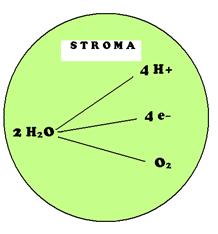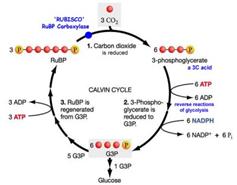The Reactions of Photosynthesis Pre Assessment Packet
Light Reactions
Stage One: Light Reactions
 When
pigments absorb light, the energy from the light is absorbed by electrons in
the pigment chlorophyll. This causes the electrons to increase their energy
level.
When
pigments absorb light, the energy from the light is absorbed by electrons in
the pigment chlorophyll. This causes the electrons to increase their energy
level.
Electrons with an increased energy level are called “excited” electrons. The increased energy level forces the excited electrons to leave the chlorophyll and enter what is called an electron transport chain. It is here that the electrons pass through a series of proteins, generating chemical energy, which is then stored in energy-carrier molecules.
Question: What do the excited electrons “carry”? Answer: ___________________.
Question: Where is this energy originally from? Answer: _________ _________.
Photolysis is also important because when water molecules break down, they give up electrons. The electrons lost during photolysis are recycled into the chlorophyll. Since electrons are always leaving the chlorophyll to enter the electron transport chain when they become excited with the sunlight, they need to constantly be replaced!
 Two water molecules are cleaved
into oxygen gas (O2), four hydrogen ions (H+) and four electrons
(e-). The chlorophyll receives its electron supply from water molecules. The
hydrogen ions are used later on to transform NADP to NADPH, and the oxygen is
released as waste.
Two water molecules are cleaved
into oxygen gas (O2), four hydrogen ions (H+) and four electrons
(e-). The chlorophyll receives its electron supply from water molecules. The
hydrogen ions are used later on to transform NADP to NADPH, and the oxygen is
released as waste.
Figure 9-1 represents the process of photolysis
Checkpoint: What happens to some of the electrons in water molecules after water is decomposed during photolysis?


The conversion of ADP into ATP or NADP+ into NADPH is how the energy from the sun is trapped in a chemical form.
Linking Light and Dark Reactions:
ATP and NADPH go on to the dark reactions of photosynthesis. During the dark reaction, ATP provides the plant with the energy necessary for the Calvin cycle. During the Calvin cycle, the energy stored in NADPH is used to create a six carbon sugar (glucose).
Questions:
- Excited Electrons
a. What is the difference between an electron found in chlorophyll vs. an excited electron?
b. When an electron becomes excited, it enters a series of reactions known as the...
- Photolysis
- Describe what is broken down during photolysis, and what individual parts it is broken down into:
b. Explain why photosynthesis could not occur without photolysis:
- The Electron Transport Chain
a. What is the role of the electron transport chain?
b. Once a molecule has accepted energy, it becomes an ____________________ ____________________. What are two examples of this?
- Describe why NADPH is important:
- Write the equation for photosynthesis below. Examine it, and use what you know from these notes to come up with 3 factors that could affect the rate (how fast or slow) at which photosynthesis occurs:

DARK (Light-Independent) Reactions of Photosynthesis
Dark reactions are the second stage of photosynthesis, and rely on the light reactions of photosynthesis.
ATP and NADPH are used for energy in the Calvin Cycle. It is called a cycle because molecules are recycled through, and used over and over again. The Calvin cycle takes place in the stroma.
Examine the equation for photosynthesis you wrote in #5 above. What reactant (left side of arrow) is not used in light reactions, which is used during the dark reactions?
Carbon fixation: a process in which plants use the carbon atom from carbon dioxide (CO2) to begin the Calvin cycle.
Summary of the Calvin Cycle: The Calvin cycle combines carbon dioxide with a 5-carbon sugar; the resulting molecule is an unstable 6-carbon sugar, which is then split into two 3-carbon molecules of phoglyceric acid (PGA). Energy from ATP and NADPH are then used to convert the phoglyeric acid molecules into phosphoglyceraldehyde (PGAL) molecules . After several rounds of the Calvin cycle, two molecules of PGAL leave the cycle and combine to form glucose. Additional PGAL molecules continue to be recycled through the Calvin cycle, and are eventually recycled into the initial 5-carbon sugar with the help of ATP. The cycle repeats.
1. What happens during carbon fixation?
2. What molecule from the atmosphere goes into the Calvin cycle?
3. What molecule comes out of the Calvin cycle?
4. What is recycled throughout the Calvin cycle?
5. Where do the dark reactions of photosynthesis take place?
6. Do you think a plant will be able to make glucose if it is a rainy, cloudy day? Under what circumstances?
Using the summary and any additional notes you have, draw the Calvin cycle in a circular path using arrows as well as rectangles listing the name of molecules in the space below: